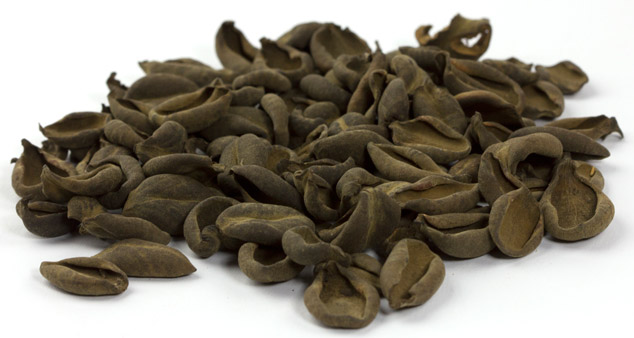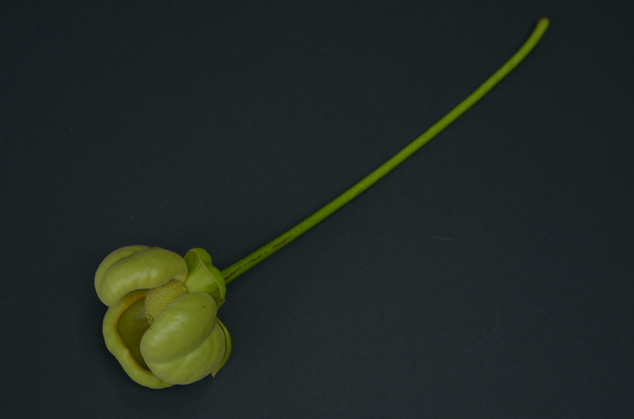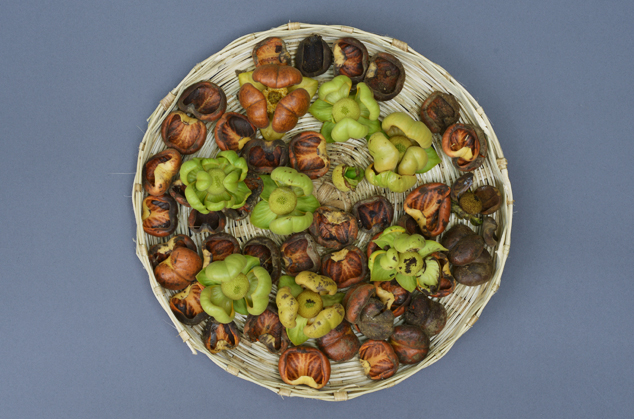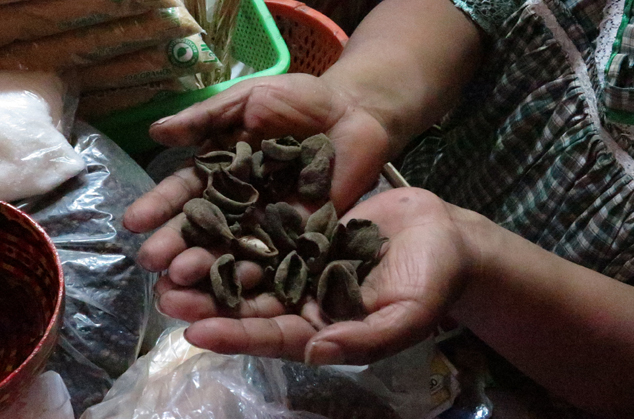In her informative book on chocolate, Sophie Coe comments on orejuela
hueinacaztli, the thick, ear-shaped petal of the flower of Cymbopetalum pendulifolorum, a tree of the Annonaceae or custard-apple family, which grows in the tropical lowland forests of Veracruz, Oazaca, and Chiapas; this was one of the most valued products brought back by the pochtexa merchants from the expeditions. It is a confusing plant, because it has a least three Nahuatl names: it may be called hueinacaztli ("great ear"), teonacaztli ("divine ear"), or xochinacaztli ("flowry ear"). The distinguishing feature is the ending nacaztli, meaning "ear."...Be that is at may, Cymbopetalum penduliflorum was the premier chocolate flavor among the Aztecs...What did this flower taste like, once it have been turned into powder and added to the fine cacao? Sahagun as usual cautions against taking too much of it, warning that excess could lead to drunkenness...
Cymbopetalum penduliflorum, Orejuela.
Cymbopetalum penduliflorum, Orejuela
The flower of this tree is renowned for its aromatic spice fragrance. The dried flower is visible in large amounts at most local markets in Guatemala City, Antigua, and Cobán. But we have not yet found one single person who can tell us where the tree grows or when it flowers.
Cymbopetalum penduliflorum, Orejuela.
Which authors first list this spice?
Most of the scientifically oriented authors of books on chocolate have given the names and dates of scores and scores of ethnohistorical records of the use of Cymbopetalum penduliflorum, Orejuela. Ironically, back in the 17th through 19th centuries, copying from original sources (often without citation) was as rife as it is on the Internet today in the 21st century.
Duran lists Xochinacaztli, ear flower, as flavoring
Diego Duran lists (Heyden 1994:244, footnote 3).
- Xochinacaztli, ear flower
- Volloxochitl, Talauma Mexicana, heart flower
- Cacaoxochitl, Rosita de cacao
- Izquixochitl, Bourreria huanita or Bourreria Formosa
- Huacalxochitl, Philodendron pseudoradiatum, carry crate flower
- Cacaloxochitl, Plumeria rubra, common in El Rancho area but grown in gardens throughout Guatemala.
DURAN, Diego and Doris HEYDEN (editor/translator) 1994 The History of the Indies of New Spain. University of Oklahoma Press.
Used to flavor tobacco
The Aztecs flavored their tobacco with
- Ear flower
- Bitumen (obviously not a plant)
- Vanilla
- Piper amalago
- Mushrooms
- Fern or narcotic root
- Uacalxochitl, Xanathosom sp or Phyllodendron affine (Philodendron ?)
- And other plants not yet identified by ethnobotanists Winter 2000: 301, citing Anderson and Dibble 1954:69
List of species of in the Mesoamerican area
What often surprises me is to learn that a plant I have been working on is in the same genus as a dozen other common plants (but the plant I am working on shows (to me, a lay person) not one single characteristic that would have given me a suspicion that it was a member of that other family.
So to learn that Cymbopetalum penduliflorum, Orejuela, is a member of the Annonaceae family (with all the Annona species (anona and cherimoya in local Spanish) was an unexpected surprise. The Annonaceae family has over one hundred genera.
Synonyms
- Uvaria penduliflora
- Porcelia cinnamomea
- Unona penduliflora
- (www.gbif.net/species/14667827)
Common names
Orejuela or orejuelo in Spanish. It is typical in Spanish for trees to have a male ending and a female ending depending on contex (or in the case of us from another country) a misunderstanding of the difference in meaning of a tree with male vs female ending).
A closely related species, C. stenophyllum, Donnell Smith, was discovered by Capt. John Donnell Smith in the Dept. of Quetzaltenango.
Cymbopetalum penduliflorum, Orejuela shown on a wicker basket.
Habitat of Cymbopetalum penduliflorum in the Mesoamerican area
You would expect to find orejuela in Guatemala, Mexico, and Belize, among other places. In Mexico it occurs in Campeche, Chiapas, Tabasco, plus Oaxaca and Veracruz (Bye and Linares 1990:161) plus Zihuatanejo de Azueta, Guerrero. http://unibio.unam.mx/collections/specimens/urn/IBUNAM:MEXU:PVsn21910
Northern Guatemala and southern Mexican border area, which means Peten and Chiapas. Also known for Belize (www.globaltrees.org/downloads/Anexo%202%20Arboles%20Guatemala.pdf)
There is a Rio El Guanacaste in the Quetzaltenango area but the Guanacaste tree is actually another tree altogether. I rarely see the name Guanacaste used for the orejuela tree in Guatemala.
Guanacaste is often included in the discussion of Cymbopetalum penduliflorum
I know the Guanacaste tree due to its large size and its use as lumber. Guanacaste is tubroo in Belize. The seed pods are called "monkey's ear tree". Guanacaste is the national tree of Costa Rica. In other countries the tree is known as Elephant Ear Tree.
But the scientific name of Guanacaste the lumber tree is Enterolobium cyclocarpum. Ear flower is Cymbopetalum penduliflorum.
The confusion is that the entire pod of a Guanacaste tree is the same of an ear. With the cacao flavoring, it is the individual "petel" which is ear-shaped. The entire pod is not ear-shaped whatsoever.
In other words, either remove the word Guanacaste from the description of ear-flower for cacao flavoring, or at least have a footnote to this FLAAR Reports page that the two "ear" items have no relation to each other: Guanacaste seeds are not used for flavoring cacao (to my knowledge).
Tabulation of indigenous terms for orejuela In Mesoamerican languages
Hueynacaztli, Manuscrit Badianus 56v
Teōnacaztli, Sahagun 11,120 and Sahagun 11,209
Cymbopetalum penduliflorum in Aztec markets
Ear flower is mentioned as one of the major products sold in Aztec markets. Bye and Linares raise the valid question of why, if ear flower was so common in Aztec markets of the pre-conquest era, why did only vanilla survive as a cacao flavoring today (1990:164).
BYE, Robert A., Jr and Edelmira LINARES
1990 Mexican Market Plants of 16th Century. I. Plants recorded in Historia Natural de Nueva Espana. J. Ethnobio. 10(2):151-168. Winter 1990.
Cymbopetalum penduliflorum, Orejuela shown in hands of a market woman.
Ear flower is mentioned as one of the major products sold in Aztec markets.
Diego Duran lists (Heyden 1994:244, footnote 3).
- Xochinacaztli, ear flower
- Volloxochitl, Talauma Mexicana, heart flower
- Cacaoxochitl, Rosita de cacao
- Izquixochitl, Bourreria huanita or Bourreria Formosa
- Huacalxochitl, Philodendron pseudoradiatum, carry crate flower
- Cacaloxochitl, Plumeria rubra, raven flower
Separately the editor has a footnote on page 179: Hueynacaxtli, Cymbopetalum penduliflorum, an aromatic plant used in the preparation of chocolate. The editor takes this from Manuscrit Badianus 56v, but does not cite the origin in her footnote.
Bibliography on Cymbopetalum penduliflorum
- 1994
- The History of the Indies of New Spain. University of Oklahoma Press.
- 1993
- Chocolate, the Food of the Gods. Chronicle Books. California.
- 2005
- Diversidad biológica en Chiapas. Plaza y Valdes, Mexico.
- 2005
- Elsevier's dictionary of trees: with names in Latin, English, French… Elsevier. 1529 pages.
- 1986
- Mansfeld's Encyclopedia of Agricultural and Horticultural Crops…. Springer.
- 1993
- Revision of Cymbopetalum and Porcelia (Annonaceae). Systematic Botany Monographs, 40.
- 1991
- La Flora Agricola. Precio En Dolares. VV. AA. 1972 pages.
- 1919
- Batido and other Guatemalan Beverages Prepared with Cacao. American Anthropologist, 21, pp. 403-409. Available on-line.
- 1911
- The sacred Ear-Flower of the Aztecs: Xochinacaztli. Smithsonian.
- 1956
- Notes on the use of cacao in Middle America. Notes on Middle American Archaeology and Ethnology, 128, 95–116. C.I.W.
- 1968
- Dictionary of economic plants. Lubrecht & Cramer Ltd. 2nd edition. 591 pages.
Pertinent web sites which mention Orejuela of Mesoamerica
http://etc.usf.edu/clipart/galleries/plants/flowers_shrubs_c.php?page=30&term University of South Florida, clipart service, excellent botanical drawings.
www.mayacodices.org/searchWiz.asp search engine for Madrid Codex.
www.plantsystematics.org/taxpage/0/genus/Cymbopetalum.html Has five photographs of various Cymbopetalum species flowers.
http://sanders5.ucr.edu/arboles_mainmenu.php?numero=29 General web site on "Arboles Tropicales Comunes del Area Maya" with basic description and photographs. University of California, Riverside.
First posted March 11, 2013.

















































































